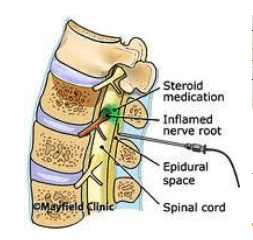Epidural Steroid Injection
(Cervical, Lumbar, Transforaminal, Caudal)
An epidural steroid injection is an injection of steroid into the epidural space. The epidural space is aspace located in the spine between the vertebrae and the dural sac, which surrounds the spinal cord.
Frequently Asked Questions
What is the purpose?
Theoretically, the steroid reduces the inflammation of the nerve roots as they exit the spine.
How is the procedure performed?
The procedure is performed under fluoroscopic x-ray guidance. The patient is lying on his/her stomach. The skin is cleaned with antiseptic solution. A local anesthetic is used to numb the skin and then the injection is performed.
How long does the procedure take?
The procedure typically takes 5-10 minutes.
What medicine is injected?
A steroid medication is injected, although sometimes, depending on which type of epidural, a local anesthetic is administered along with the steroid.
Will the injection hurt?
The procedure is performed under local anesthetic, which is used to numb the skin and deeper tissues. You may feel a burning sensation that will last only a few seconds from the local anesthetic and some pressure but typically not much pain.
How will I feel after the injection?
You may have a sore back briefly after the injection because of the medication that was injected but then you should feel some relief. Using an ice pack for 20 minutes a few times that day will help with this.
How long does the effect of the injection last?
The steroid starts having an effect in 24 to 48 hours and may last several days to several months. Everyone is different and there is great variability among patients.
How many injections can I have in a year?
The number will depend upon the cause of your pain and whether or not you have other health related issues.
What are the side effects of the injection?
Initial side effect is local soreness from the injection. Ice for 20-minutes throughout the day will help with this. Late side effects are related to the steroid. Elevated blood sugars for 24 to 48 hours, therefore if you are diabetic, increase the amount of blood sugar checks. Also flushing of the face, dizziness, and headaches may occur.
What are the possible complications of the procedure?
The most common complication is dural sac puncture, which could cause headache. The other complications are bleeding and infection, but these are rare. Very uncommon complications include nerve or spinal cord injury.
Who should not have the injection?
If you are taking any drugs that affect blood coagulation (blood thinners such as Plavix, Coumadin, Xarelto, Eliquis, or others) or if you have any active infection, you should not have the procedure without further discussion. Also, please warn us of any allergies, especially to local anesthetics, x-ray dye, seafood, and latex.











